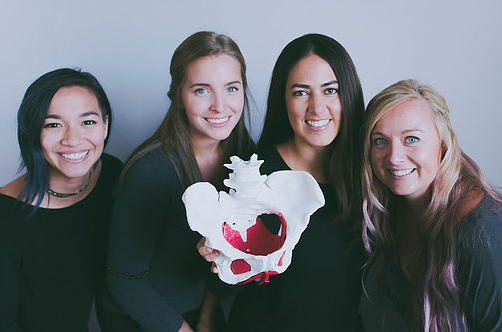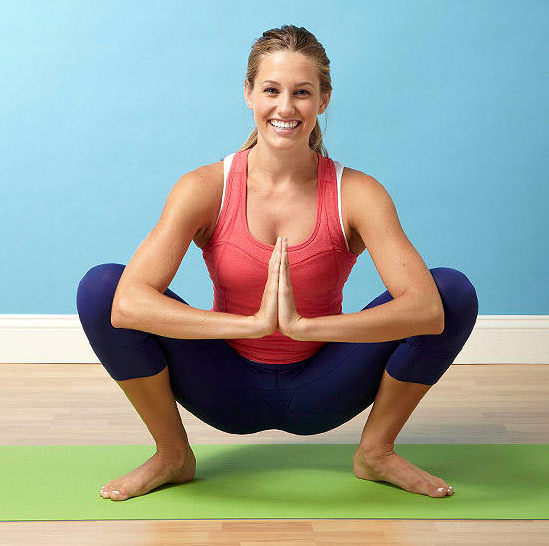Hi loves!
Today’s post is going to be all about pelvic health and wellness. Think: painful intercourse, UTI’s, hormonal imbalance, digestion issues, etc!
I brought on my one of my best friends (who is also newly engaged (congrats!)), Dr. Amy Renslo to the blog today to educate us on all things pelvic health.
Dr. Amy Renslo is a pelvic floor physical therapist who received her Doctorate in Physical Therapy from Regis University in Colorado following her undergraduate degree in Kinesiology from Washington State University.
Let’s dive in!

Hello Miss Dr. Amy Renslo! Okay, please introduce yourself:
Hi guys! 🙂 I am a pelvic physical therapist working at PelvicSanity in the OC. My educational background is in orthopedics with an emphasis on treating pelvic conditions! As you guys will see pelvic therapy is a unique field (like something you have probs never heard of before) but I figured it out after my mom struggled from post-surgical complications. I’m SO excited to share the information I practice each day with you babes! Consider this Pelvic floor 101…
Some of us might not know, so where the hell is the pelvic floor && what does it do?
Okay, so first things first, the pelvic floor is the most overlooked muscle group in the body! It has been neglected for a long time in the medical field and is rarely discussed by MD’s and traditional PT’s.
The “pelvic floor” is a name used to describe all the muscles, ligaments, nerves, vessels, and connective tissue the stretch across the pelvis. This area is super important because it is truly the floor of our core, it connects our upper and lower body, and is the only thing between your internal organs and the ground (so it’s a big deal)!
The Pelvic floor has 4 major functions which are essential for everyday life!
- Sphincter: the pelvic floor is responsible for controlling bathroom use. Either contracting to keep you from peeing yourself or relaxing to let you have a bowel movement!
- Stabilizing: it provides added support to low back and boney pelvis.
- Supportive: the pelvic floor supports ALL of the organs in our pelvic cavity (basically a hammock for the bladder, vagina, prostate, uterus, and rectum)
- Sexual: it is responsible for sexual functions such as arousal and orgasm (for both males and females)!
If it wasn’t for you, I would have had no idea you could do physical therapy to treat pelvic health. How does Pelvic floor physical therapy help?
Pelvic PT focuses restoring the 4 major functions of the pelvic floor (those 4 S’s we just reviewed). We do this through many techniques such as:
- mobilizations/manipulations to the pelvis/surrounding joints (basically re-setting nervous system signals going to the pelvic floor)
- trigger point release (working to restore normal muscle tone by working on painful and knotted muscles)
- fascial release (releasing connective tissue adhesions that can cause pain and inflammation to the pelvis)
- looking beyond the pelvis (our pelvis is the cross road of our upper and lower body and is influenced by poor posture and even flat feet)!
What kind of concerns do you treat?
Because I practice at a specialty clinic we see everything “pelvic” related! Pelvic conditions for both men and women ranging from pain with intercourse/erectile dysfunction to low back pain. Specifically I treat…
- Orthopedic conditions: low back pain, SI joint pain, etc.
- Pelvic pain conditions: chronic constipation, pelvic floor muscle spasm, IBS, etc.
- Pregnancy and postpartum: back pain/hip pain, incontinence, etc.
- Post-surgical care: C-section, hysterectomy, and any other abdominal surgery
- Urinary conditions: incontinence, urinary frequency/urgency, recurring UTI’s
- Male pelvic pain: erectile dysfunction, testicular/penile pain, etc.
- Female pelvic pain: endometriosis, painful intercourse (dyspareunia), etc.
What are the most common symptoms you treat daily?
Each day is so different, at PelvicSanity we specialize in complex pelvic floor conditions. So some days my patients come in with pain with intercourse and endometriosis and other days patient’s post-prostatectomy (prostate removal) or with pelvic organ prolapse (when an organ “falls” through the pelvic floor hammock…yes that truly happens).
Alright, so if I have a UTI, I should come to you?
The answer is it depends! If you suffer from frequent UTI’s that is a sign telling me there is potentially something else going on in the pelvic floor that is making you more prone to them. It is also really important to see if your UTI culture is positive for bacteria; often medical providers will prescribe antibiotics for UTI SYMPTOMS even if there is NO infection present…or if they never ran a culture. The burning sensation of a UTI that is negative for infection can be the culprit of pelvic floor dysfunction such as interstitial cystitis or pelvic floor muscle spasm!!
How is your holistic approach to physical therapy different than the traditional physical therapy?
Good question! At PelvicSanity we are a specialized pelvic physical therapy clinic (which is unique because all us therapist have training and additional education in this field) that treats each patient 1:1 for a full 60 minute treatment session. We not only address the condition the patient comes in with but also review posture, exercises, supplements, and often refer patients to other specialists to address all aspects of their individual problem. This model is much different than most physical therapy clinics.
When looking for a physical therapist for a pelvic dysfunction, make sure you do you research and find a clinician who is specialized in the area. For more information about finding a Physical Therapist that fits YOU click here for the six strategies for finding a pelvic physical therapist.
Why don’t most Doctors refer their patients to pelvic floor physical therapy?
Most medical professionals (even gynecologists) only get 1 hour-long lecture in medical school on the muscles of the pelvic floor. Unfortunately most doctors are unaware of pelvic PT and the benefit it has for their patients and their pelvic floor dysfunction. Although more and more research is coming out on the benefits of Pelvic PT we still see a gap in the knowledge of pelvic health in our medical field. Pelvic PT is a relatively new specialty and as we continue to market to other medical professionals we hope more awareness comes forward!!!
That is insane! Is there anything we can do on our own to get better??!
Heck Yes!
A few of our fav pelvic floor specific stretches include happy baby and deep squat!


You can also do the below:
- Take a hot bath: It increases blood flow through the region and can help carry away inflammation.
- Practice Deep Breathing: this type of breathing can help relax the pelvic floor.
- Take up yoga
- Avoid prolonged sitting: When you sit, your glute muscles slide up, leaving all of your weight resting directly on the muscles of your pelvic floor. This can cause your muscles to tighten up, compressing the nerves that run through the pelvic floor and causing pain, urinary symptoms, or other pelvic problems.
- Go for a walk: The act of walking engages the muscles of the legs, abdomen, lower back, and the rest of the core.
- Give yourself a massage: A foam roller is a great tool for this self-massage. By slowly rolling your body body over the roller, you can massage out tight spots that may be causing pain or dysfunction.
Is there any supplements we should be taking or food we should be eating to take care of our pelvic health?
Oh my gosh, definitely!
As you mentioned UTI before I will touch on a great supplement for a POSTIVE culture for E.coli (your doc will usually mention this when you get your urine culture back). The Supplement is called D-Mannose and it naturally prevents UTI’s by binding to E.Coli (which is the culprit of up to 80% of all UTI’s). Recommended dose is 2,000MG per day while infection present.
Another great supplement is Vitamin D3, has been shown to help with chronic pelvic pain and immune support. Recommend taking 2,000IU per day. Visit here for more information on the crazy impact Vitamin D deficiency has on our bodies.
Others:
- Omega-3 Fish oil. Find a ratio of EPA to DHA of 2:1. (You can find Amy’s Favorite brand here) Studies show it decreases inflammation and can help with period cramps (even endometriosis)
- WATER… more than 64 ounces/day
- EAT HEALTHY…a well-rounded diet helps with pelvic floor function.. check out our blog for more details
As you know, I have a lot of digestion issues – what should I be doing to relieve symptoms?
Many of our patients come in with digestive issues as their sole complaint or in addition to addition to another dysfunction. Some good starting points for digestive dysfunction is…
- Find your trigger foods/drinks: document (actually keep a food log) what foods impact your digestion, do you notice increased bloating after certain foods? Increased constipation? Or even increased diarrhea?
- Toilet with optimal posture: The SquattyPotty is no joke and truly works wonders for bowel movements. Trial using a stool to get your knees above your hips for the next time you have to go # 2 and notice the difference in ease of bowel movements.
- I love you massage, to help digestion/bloating move through large intestine (See below).


So every time I look back, Trevor has to pee. He’s too stubborn to get it checked out so please, how would you handle?
Ohhhh, Trevor! So it’s normal to use the restroom up to 8 times per day, if he is going over that it is abnormal! Start to track exactly how many times he is using the bathroom/ how much liquid he is drinking during the day to see if it matches.
Our bladders are like a toddler, the more you give it something the more it asks for it. SO if you get in the habit of peeing before you truly have a full bladder you re-train it to thinking it is full when in all actuality only 50% filled!
I would be interested with Trevor to see if this became a problem after his back surgery… in a study of women 95% of those who documented having low back pain also had pelvic floor muscle dysfunction.
Alright while I’m tracking the amount of times Trevor pees, tell us –
RANDOM FACTS ABOUT PELVIC HEALTH:
- 1 in 4 women have a pelvic floor disorder!!!
- Coughing put more strain on your pelvic floor than lifting, running, jumping, or sit-ups !!
- Pelvic physical therapy does not mean performing kegals!! In fact most women who come in to see us have hypertonic (increased tone) in their pelvic floor
- An estimated 1 in 10 women have endometriosis!
- There are good and bad PT’s, even if pelvic therapy did not work with you for with one therapist try another. Each therapist has their own treatment style and maybe their style wasn’t a good for you, but that doesn’t mean pelvic PT won’t help!
- 60% of moms continue to have a diastasis recti (separation of abdominal muscles) 6 weeks after delivery
This was fabulous. Every woman will be able to relate to something in this article and not just younger women, but also older women as they go through menopause.
Can you recommend a good pelvic floor thyipist in grand rapids mi , mine tells me to do kegls and they cause me more ic pain
[…] can read our other blog here on all things pelvic health. (One of the most popular blog posts on the […]